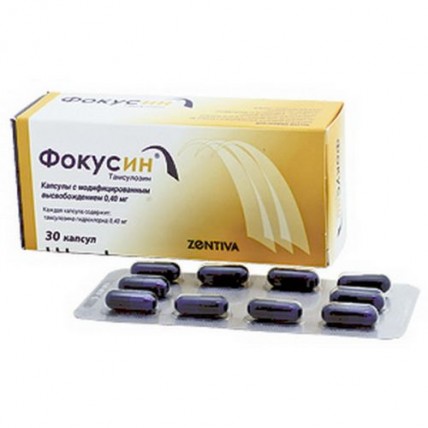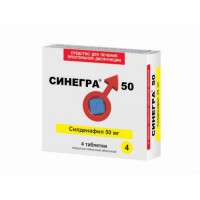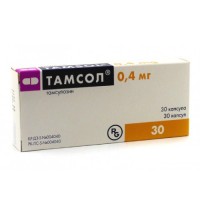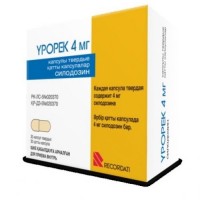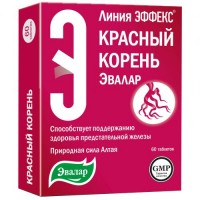Fokusin 30s 40 mg modified-release capsules
- $28.40
The instruction for medical use
of FOKUSIN® medicine
Trade name
ФОКУСИН®
the International unlicensed
name Tamsulozin Lekarstvennaya
the Capsule form with the modified release of 0.4 mg
Structure
One capsule contains
active agent - a tamsulozin a hydrochloride of 0.4 mg (tamsulozin – 0.367 mg)
excipients: methacrylic acid – acrylate ethyl a kopolimer (1:1) dispersions of 30%, cellulose microcrystalline, dibutilsebakat, polysorbate 80, silicon dioxide colloidal anhydrous, talc.
lid and body of the capsule: azoruby (E 122), patent blue V (E 131), gelatin.
The description
Solid gelatin capsules with a transparent lid and the body of dark blue color.
Contents of capsules – from white till almost white color of a micropellet.
Pharmacotherapeutic group
Drugs for treatment of urological diseases.
Drugs for treatment of a benign hypertrophy of a prostate.
Alfa1-adrenoblokatory.
Tamsulozin.
The ATX G04CA02 code
the Pharmacological
Tamsulozin Pharmacokinetics Absorption properties is soaked up in a small intestine, and its bioavailability is nearly 100%. Absorption of a tamsulozin decreases if to take the drug right after food.
The uniformity of absorption of the drug FOKUSIN® is provided with reception after a breakfast or the first meal (in one and too time).
The kinetics of a tamsulozin is linear.
After single dose of a tamsulozin after meal, the maximum concentration in blood plasma is reached approximately in 6 hours. The condition of equilibrium concentration is reached after the 5th day course when Cmax at patients is nearly two thirds higher than after single dose of drug. Without looking, that this effect was confirmed only at patients of advanced age, the same results are expected at young patients.
The significant individual distinctions are characteristic of plasma concentration of drug after single and multiple dose.
Distribution
At people about 99% of a tamsulozin contacts proteins of plasma, and its volume of distribution is insignificant (about 0.2 l/kg).
Biotransformation
At a tamsulozin is noted low metabolic effect of the first passing. The most part of a tamsulozin is present at plasma in not changed look. Drug is metabolized in a liver.
Regulation of a dosage is not need in a moderate liver failure.
Metabolites are not so effective and toxic as influence of directly active ingredient of drug.
Discharge
Tamsulozin and its metabolites are mainly emitted with urine, about 9% of this dose are allocated in not changed form.
Elimination half-life of a tamsulozin at patients makes about 10 hours (accepted after a meal) and 13 hours in not changed look.
In a renal failure
the Dose decline in the presence at the patient of a heavy renal failure (clearance of creatinine & lt, 10 ml/min.) has to be carried out with care.
The pharmacodynamics
the action Mechanism
Tamsulozin selekitvno and competitively contacts postsynaptic α1-адренорецепторами especially with a1a and a1D subtypes. Thus relaxation of unstriated muscles of a prostate and urethra which leads to reduction of a tone and improvement of urination is reached.
Pharmakodinamichesky effects
Tamsulozin reduces a tone of smooth muscles of a prostate and an urethra, improving urine outflow. It leads to reduction of symptoms of obstruction and irritation.
Tamsulozin also reduces the symptoms accompanying urine deduction in which development a significant role is played by an unstable condition of a bladder. Effects concerning symptoms of an ischuria and disturbance of urination remains at long therapy. These effects allow to delay considerably need of performing surgical treatment or catheterization.
α1-блокаторы reduce arterial blood pressure, lowering peripheric resistance. At the patients having normal arterial blood pressure clinical a significant lowering of arterial pressure it was not observed.
Indications
- dysuric disorders in the benign hyperplasia of a prostate (BHP).
The route of administration and doses
Is accepted inside on one capsule daily after a breakfast or the first meal. The capsule is swallowed entirely, without breaking its integrity and without chewing as it can influence the controlled release of active ingredient.
The course of treatment is defined by individually attending physician.
Side effects
Often (from & gt, 1/100 to & lt, 1/10)
- dizziness
Infrequently (from & gt, 1/1000 to & lt, 1/100)
- headaches
- heartbeat
- orthostatic hypotension
- rhinitis
- a constipation, diarrhea, nausea, vomiting
- rash, an itching, urticaria
- the asthenia
Seldom (from & gt, 1/10000 to & lt, 1/1000)
- a syncope
- a Quincke's disease
Very seldom (& lt, 1/10000)
- a priapism
-
Stephens-Johnson Chastot's syndrome is not known (it is impossible to establish proceeding from the available data)
- indistinct sight, a disorder of vision
- nasal bleeding
- a multiformny erythema, exfoliative dermatitis
- disturbances of an ejaculation, the retrograde ejaculation, lack of an ejaculation
- dryness in a mouth
When using drug in the post-marketing period were observed the cases of a syndrome of a narrow pupil, a so-called syndrome intraoperative instability of an iris of the eye of an eye (Intraoperative Floppy Iris Syndrome) associated with use of a tamsulozin during surgery apropos a cataract.
Post-marketing experience of use: besides above-mentioned undesirable reactions, there are messages about cases of fibrillation of auricles, arrhythmias, tachycardias and asthmas associated with use of a tamsulozin of a hydrochloride. Because about these phenomena it is reported in spontaneous messages about post-marketing experience of use around the world, it is impossible to establish authentically the frequency of cases and a role of a tamsulozin in emergence of such reactions.
Contraindications
- hypersensitivity to a tamsulozin to a hydrochloride or to any of excipients, including a medicamentous Quincke's disease
- orthostatic hypotension in the anamnesis
- a heavy liver failure
- with care - a heavy renal failure (clearance of creatinine less than 10 ml/min.)
- children's age up to 18 years
Medicinal interactions
At the accompanying purpose of a tamsulozin of a hydrochloride with atenolol, enalapril or theophylline were not observed any interactions. At simultaneous use with Cimetidinum causes increase in concentration of a tamsulozin in blood plasma, with furosemide - decrease in concentration, however it does not demand change of a dose of Fokusina® as concentration of drug remains within normal range.
Diazepam, propranolol, trikhlormetiazid, chlormadinon, amitriptyline, diclofenac, glibenclamide, simvastatin and warfarin do not influence free fraction of a tamsulozin in plasma of the person of in vitro. As well as tamsulozin does not influence free fractions of diazepam, propranolol, a trikhlormetiazid and chlormadinon.
Diclofenac and warfarin can increase the clearance rate of a tamsulozin several.
Simultaneous use of a tamsulozin of a hydrochloride with strong CYP3A4 inhibitors can be led to strengthening of influence of a tamsulozin of a hydrochloride. Parallel reception with ketokonazoly (the known strong CYP3A4 inhibitor) led to increase in AUC and Cmax of a tamsulozin of a hydrochloride in 2.8 and 2.2 times, respectively.
Tamsulozin a hydrochloride it is not necessary to appoint in combination with strong CYP3A4 inhibitors at patients of a phenotype a slow metabolizator on CYP2D6.
It is necessary to be careful at use of a tamsulozin of a hydrochloride in combination with strong and moderate CYP3A4 inhibitors.
Simultaneous use of a tamsulozin of a hydrochloride with paroksetiny, strong CYP2D6 inhibitor, led to increase in Cmax and AUC of a tamsulozin in 1.3 and 1.6, respectively, however this increase is not considered clinically significant.
Co-administration of other antagonists of a1-adrenoceptors can lead to strengthening of hypotensive effect.
Special instructions
As well as at use of other antagonists of a1-adrenoceptors, at treatment of a tamsulozin a hydrochloride decrease in the ABP of blood is in some cases possible, it is very rare - development of an unconscious state. At the first symptoms of orthostatic hypotension of the patient it is necessary to put or put before disappearance of these symptoms. Before an initiation of treatment of a tamsulozin a hydrochloride of the patient it has to be carefully surveyed for an exception of other diseases which symptoms are similar to symptoms of a benign hyperplasia of a prostate. Before an initiation of treatment and further it is necessary to perform with regular intervals manual examination of a prostate through a large intestine and if necessary to determine the level of specific antigen of a prostate (DOG).
With a heavy renal failure (clearance of creatinine & lt, 10 ml/minute) it is necessary to approach treatment of patients with care as these patients were not studied.
Vascular swelled seldom appears after use of a tamsulozin. In case of vascular hypostasis the treatment has to be immediately stopped, the patient has to be under observation before disappearance of hypostasis, and tamsulozin should not be applied repeatedly.
During operation of a cataract at some patients who were treated or treated a tamsulozina by a hydrochloride the syndrome of intraoperative instability of an iris of the eye of an eye (Intraoperative Floppy Iris Syndrome, a syndrome of a narrow pupil) was observed.
The syndrome of a narrow pupil can lead to the increased procedural complications in time and after operation.
The termination of treatment of tamsuloziny 1 - 2 week to operation of a cataract is considered useful, favorable, and duration of the necessary termination of treatment of a tamsulozin, however, was not established yet.
It is not recommended to begin therapy of a tamsulozin with a hydrochloride at patients at whom surgery concerning a cataract is planned. During preoperative preparation the experts have to take into account, reception of a tamsulozin, for acceptance of adequate measures of treatment in management of possible development of a syndrome of a narrow pupil during operation.
Tamsulozin a hydrochloride should not be accepted in combination with strong CYP3A4 inhibitors at patients of a phenotype a slow metabolizator on CYP2D6.
Pregnancy and the period of a lactation
Tamsulozin is not intended for use for women.
Features of influence of medicine on ability to run the vehicle or potentially dangerous mechanisms
of the Research of impacts on ability of driving and control of devices were not carried out. However, patients need to report about a possibility of development of dizziness.
Overdose
Symptoms: acute hypotension can develop (which was observed at overdose of various degree).
Treatment: Holding the actions supporting function of a cardiovascular system is required. In case of the acute hypotension which arose after overdose it is necessary to hold treatment on support of a cardiovascular system. To normalize arterial blood pressure and heart rate it is possible to restore by reduction of the patient in horizontal position. At inefficiency of this action it is possible, administration of the objyomo-substituting solutions and if necessary administration of vasoconstrictors will be required. It is necessary to control function of kidneys and to hold the events directed to its maintenance. Dialysis is not effective since it tamsulozin contacts proteins of blood plasma in very large numbers. For prevention of absorption it is necessary to cause vomiting. In case of overdose by a large amount of drug, it is necessary to carry out gastric lavage and also it is necessary to appoint intake of activated carbon and osmotic depletive, for example, of sulfate sodium.
The form of release and packing
On 10 capsules place in blister strip packaging from a firm colourless film of polyvinylchloride and aluminum foil.
On 3, 9 and 10 blister strip packagings together with the instruction for medical use in the state and Russian languages put in a pack from cardboard.
Storage conditions
At a temperature from +10 °C to +25 °C. To store out of children's reach.
3 years
not to apply a period of storage after an expiration date.
Prescription status
According to the prescription.
The producer Zentiva of ampere-second., Glogovets, the Slovak Republic for Zentiva to. page, At a kabelovna 130, 102 37, Prague 10, Dolni Mekholupy, the Czech Republic.
The owner of the registration certificate
Zentiva to. village, Czech Republic.
The address of the organization accepting in the territory of the Republic of Kazakhstan claims from consumers on quality of products (goods) of Sanofi-aventis Kazakhstan LLP 050016 Almaty, Kunayev St. 21btelefon: 8-727-244-50-96факс:
To Develop 8-727-258-25-96e-mail:quality.info@sanofi.com
of FOKUSIN® medicine
Trade name
ФОКУСИН®
the International unlicensed
name Tamsulozin Lekarstvennaya
the Capsule form with the modified release of 0.4 mg
Structure
One capsule contains
active agent - a tamsulozin a hydrochloride of 0.4 mg (tamsulozin – 0.367 mg)
excipients: methacrylic acid – acrylate ethyl a kopolimer (1:1) dispersions of 30%, cellulose microcrystalline, dibutilsebakat, polysorbate 80, silicon dioxide colloidal anhydrous, talc.
lid and body of the capsule: azoruby (E 122), patent blue V (E 131), gelatin.
The description
Solid gelatin capsules with a transparent lid and the body of dark blue color.
Contents of capsules – from white till almost white color of a micropellet.
Pharmacotherapeutic group
Drugs for treatment of urological diseases.
Drugs for treatment of a benign hypertrophy of a prostate.
Alfa1-adrenoblokatory.
Tamsulozin.
The ATX G04CA02 code
the Pharmacological
Tamsulozin Pharmacokinetics Absorption properties is soaked up in a small intestine, and its bioavailability is nearly 100%. Absorption of a tamsulozin decreases if to take the drug right after food.
The uniformity of absorption of the drug FOKUSIN® is provided with reception after a breakfast or the first meal (in one and too time).
The kinetics of a tamsulozin is linear.
After single dose of a tamsulozin after meal, the maximum concentration in blood plasma is reached approximately in 6 hours. The condition of equilibrium concentration is reached after the 5th day course when Cmax at patients is nearly two thirds higher than after single dose of drug. Without looking, that this effect was confirmed only at patients of advanced age, the same results are expected at young patients.
The significant individual distinctions are characteristic of plasma concentration of drug after single and multiple dose.
Distribution
At people about 99% of a tamsulozin contacts proteins of plasma, and its volume of distribution is insignificant (about 0.2 l/kg).
Biotransformation
At a tamsulozin is noted low metabolic effect of the first passing. The most part of a tamsulozin is present at plasma in not changed look. Drug is metabolized in a liver.
Regulation of a dosage is not need in a moderate liver failure.
Metabolites are not so effective and toxic as influence of directly active ingredient of drug.
Discharge
Tamsulozin and its metabolites are mainly emitted with urine, about 9% of this dose are allocated in not changed form.
Elimination half-life of a tamsulozin at patients makes about 10 hours (accepted after a meal) and 13 hours in not changed look.
In a renal failure
the Dose decline in the presence at the patient of a heavy renal failure (clearance of creatinine & lt, 10 ml/min.) has to be carried out with care.
The pharmacodynamics
the action Mechanism
Tamsulozin selekitvno and competitively contacts postsynaptic α1-адренорецепторами especially with a1a and a1D subtypes. Thus relaxation of unstriated muscles of a prostate and urethra which leads to reduction of a tone and improvement of urination is reached.
Pharmakodinamichesky effects
Tamsulozin reduces a tone of smooth muscles of a prostate and an urethra, improving urine outflow. It leads to reduction of symptoms of obstruction and irritation.
Tamsulozin also reduces the symptoms accompanying urine deduction in which development a significant role is played by an unstable condition of a bladder. Effects concerning symptoms of an ischuria and disturbance of urination remains at long therapy. These effects allow to delay considerably need of performing surgical treatment or catheterization.
α1-блокаторы reduce arterial blood pressure, lowering peripheric resistance. At the patients having normal arterial blood pressure clinical a significant lowering of arterial pressure it was not observed.
Indications
- dysuric disorders in the benign hyperplasia of a prostate (BHP).
The route of administration and doses
Is accepted inside on one capsule daily after a breakfast or the first meal. The capsule is swallowed entirely, without breaking its integrity and without chewing as it can influence the controlled release of active ingredient.
The course of treatment is defined by individually attending physician.
Side effects
Often (from & gt, 1/100 to & lt, 1/10)
- dizziness
Infrequently (from & gt, 1/1000 to & lt, 1/100)
- headaches
- heartbeat
- orthostatic hypotension
- rhinitis
- a constipation, diarrhea, nausea, vomiting
- rash, an itching, urticaria
- the asthenia
Seldom (from & gt, 1/10000 to & lt, 1/1000)
- a syncope
- a Quincke's disease
Very seldom (& lt, 1/10000)
- a priapism
-
Stephens-Johnson Chastot's syndrome is not known (it is impossible to establish proceeding from the available data)
- indistinct sight, a disorder of vision
- nasal bleeding
- a multiformny erythema, exfoliative dermatitis
- disturbances of an ejaculation, the retrograde ejaculation, lack of an ejaculation
- dryness in a mouth
When using drug in the post-marketing period were observed the cases of a syndrome of a narrow pupil, a so-called syndrome intraoperative instability of an iris of the eye of an eye (Intraoperative Floppy Iris Syndrome) associated with use of a tamsulozin during surgery apropos a cataract.
Post-marketing experience of use: besides above-mentioned undesirable reactions, there are messages about cases of fibrillation of auricles, arrhythmias, tachycardias and asthmas associated with use of a tamsulozin of a hydrochloride. Because about these phenomena it is reported in spontaneous messages about post-marketing experience of use around the world, it is impossible to establish authentically the frequency of cases and a role of a tamsulozin in emergence of such reactions.
Contraindications
- hypersensitivity to a tamsulozin to a hydrochloride or to any of excipients, including a medicamentous Quincke's disease
- orthostatic hypotension in the anamnesis
- a heavy liver failure
- with care - a heavy renal failure (clearance of creatinine less than 10 ml/min.)
- children's age up to 18 years
Medicinal interactions
At the accompanying purpose of a tamsulozin of a hydrochloride with atenolol, enalapril or theophylline were not observed any interactions. At simultaneous use with Cimetidinum causes increase in concentration of a tamsulozin in blood plasma, with furosemide - decrease in concentration, however it does not demand change of a dose of Fokusina® as concentration of drug remains within normal range.
Diazepam, propranolol, trikhlormetiazid, chlormadinon, amitriptyline, diclofenac, glibenclamide, simvastatin and warfarin do not influence free fraction of a tamsulozin in plasma of the person of in vitro. As well as tamsulozin does not influence free fractions of diazepam, propranolol, a trikhlormetiazid and chlormadinon.
Diclofenac and warfarin can increase the clearance rate of a tamsulozin several.
Simultaneous use of a tamsulozin of a hydrochloride with strong CYP3A4 inhibitors can be led to strengthening of influence of a tamsulozin of a hydrochloride. Parallel reception with ketokonazoly (the known strong CYP3A4 inhibitor) led to increase in AUC and Cmax of a tamsulozin of a hydrochloride in 2.8 and 2.2 times, respectively.
Tamsulozin a hydrochloride it is not necessary to appoint in combination with strong CYP3A4 inhibitors at patients of a phenotype a slow metabolizator on CYP2D6.
It is necessary to be careful at use of a tamsulozin of a hydrochloride in combination with strong and moderate CYP3A4 inhibitors.
Simultaneous use of a tamsulozin of a hydrochloride with paroksetiny, strong CYP2D6 inhibitor, led to increase in Cmax and AUC of a tamsulozin in 1.3 and 1.6, respectively, however this increase is not considered clinically significant.
Co-administration of other antagonists of a1-adrenoceptors can lead to strengthening of hypotensive effect.
Special instructions
As well as at use of other antagonists of a1-adrenoceptors, at treatment of a tamsulozin a hydrochloride decrease in the ABP of blood is in some cases possible, it is very rare - development of an unconscious state. At the first symptoms of orthostatic hypotension of the patient it is necessary to put or put before disappearance of these symptoms. Before an initiation of treatment of a tamsulozin a hydrochloride of the patient it has to be carefully surveyed for an exception of other diseases which symptoms are similar to symptoms of a benign hyperplasia of a prostate. Before an initiation of treatment and further it is necessary to perform with regular intervals manual examination of a prostate through a large intestine and if necessary to determine the level of specific antigen of a prostate (DOG).
With a heavy renal failure (clearance of creatinine & lt, 10 ml/minute) it is necessary to approach treatment of patients with care as these patients were not studied.
Vascular swelled seldom appears after use of a tamsulozin. In case of vascular hypostasis the treatment has to be immediately stopped, the patient has to be under observation before disappearance of hypostasis, and tamsulozin should not be applied repeatedly.
During operation of a cataract at some patients who were treated or treated a tamsulozina by a hydrochloride the syndrome of intraoperative instability of an iris of the eye of an eye (Intraoperative Floppy Iris Syndrome, a syndrome of a narrow pupil) was observed.
The syndrome of a narrow pupil can lead to the increased procedural complications in time and after operation.
The termination of treatment of tamsuloziny 1 - 2 week to operation of a cataract is considered useful, favorable, and duration of the necessary termination of treatment of a tamsulozin, however, was not established yet.
It is not recommended to begin therapy of a tamsulozin with a hydrochloride at patients at whom surgery concerning a cataract is planned. During preoperative preparation the experts have to take into account, reception of a tamsulozin, for acceptance of adequate measures of treatment in management of possible development of a syndrome of a narrow pupil during operation.
Tamsulozin a hydrochloride should not be accepted in combination with strong CYP3A4 inhibitors at patients of a phenotype a slow metabolizator on CYP2D6.
Pregnancy and the period of a lactation
Tamsulozin is not intended for use for women.
Features of influence of medicine on ability to run the vehicle or potentially dangerous mechanisms
of the Research of impacts on ability of driving and control of devices were not carried out. However, patients need to report about a possibility of development of dizziness.
Overdose
Symptoms: acute hypotension can develop (which was observed at overdose of various degree).
Treatment: Holding the actions supporting function of a cardiovascular system is required. In case of the acute hypotension which arose after overdose it is necessary to hold treatment on support of a cardiovascular system. To normalize arterial blood pressure and heart rate it is possible to restore by reduction of the patient in horizontal position. At inefficiency of this action it is possible, administration of the objyomo-substituting solutions and if necessary administration of vasoconstrictors will be required. It is necessary to control function of kidneys and to hold the events directed to its maintenance. Dialysis is not effective since it tamsulozin contacts proteins of blood plasma in very large numbers. For prevention of absorption it is necessary to cause vomiting. In case of overdose by a large amount of drug, it is necessary to carry out gastric lavage and also it is necessary to appoint intake of activated carbon and osmotic depletive, for example, of sulfate sodium.
The form of release and packing
On 10 capsules place in blister strip packaging from a firm colourless film of polyvinylchloride and aluminum foil.
On 3, 9 and 10 blister strip packagings together with the instruction for medical use in the state and Russian languages put in a pack from cardboard.
Storage conditions
At a temperature from +10 °C to +25 °C. To store out of children's reach.
3 years
not to apply a period of storage after an expiration date.
Prescription status
According to the prescription.
The producer Zentiva of ampere-second., Glogovets, the Slovak Republic for Zentiva to. page, At a kabelovna 130, 102 37, Prague 10, Dolni Mekholupy, the Czech Republic.
The owner of the registration certificate
Zentiva to. village, Czech Republic.
The address of the organization accepting in the territory of the Republic of Kazakhstan claims from consumers on quality of products (goods) of Sanofi-aventis Kazakhstan LLP 050016 Almaty, Kunayev St. 21btelefon: 8-727-244-50-96факс:
To Develop 8-727-258-25-96e-mail:quality.info@sanofi.com
